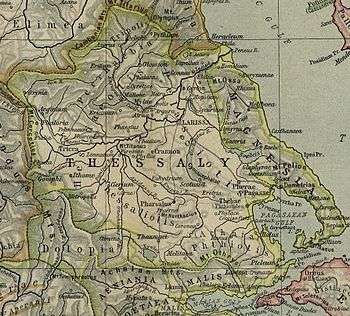Mylae (Thessaly)
Mylae (Ancient Greek: Μυλαί) was a town and polis (city-state)[1] of Perrhaebia in ancient Thessaly.[2][3] Livy describes recounts the battle for the town during the Third Macedonian War, in 171 BCE. The army of Perseus of Macedon, having obtained the surrender of Pythium, Azorus, and Doliche, and having taken Cyretiae, went against the city of Mylae, but it was very well fortified and its inhabitants resisted a siege of three days. On the fourth day, when the defenders were exhausted, the Macedonians launched a stronger attack against the walls and the door but the defenders rejected them and even made a sortie against the Macedonians. Given their numerical inferiority, however, the defenders had to flee their city, and the Macedonians were able to penetrate through the doors that were open, took the city, looted it, and sold it to the men who survived as slaves.[2]

Mogens Herman Hansen identifies the site of Mylae as being just north of the modern town of Vlachogianni,[4] while for others the identification with the Vlachogianni site is only tentative.[5][6]
References
- Mogens Herman Hansen & Thomas Heine Nielsen (2004). "Thessaly and Adjacent Regions". An inventory of archaic and classical poleis. New York: Oxford University Press. pp. 724-725. ISBN 0-19-814099-1.
- Livy. Ab Urbe Condita Libri (History of Rome). 42.54.
- Stephanus of Byzantium. Ethnica. sub voce.
- Mogens Herman Hansen & Thomas Heine Nielsen (2004). "Thessaly and Adjacent Regions". An inventory of archaic and classical poleis. New York: Oxford University Press. p. 724. ISBN 0-19-814099-1.
- Richard Talbert, ed. (2000). Barrington Atlas of the Greek and Roman World. Princeton University Press. p. 55, and directory notes accompanying.
- Lund University. Digital Atlas of the Roman Empire.
![]()